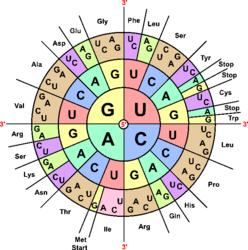
A codon is a three-nucleotide sequence of DNA or RNA that corresponds to a particular amino acid sequence or a stop signal during the synthesis of proteins; the codons specify which amino acid will be added next during protein biosynthesis. With very specific exceptions,[1] each one of the codons has stored information to code a single amino acid or a stop signal, and the entire set of codons is referred to as the genetic code.[2] Living cells use this genetic code to translate stored information within the genetic material into protein.
There are 64 possible three-letter nucleotide sequence combinations that can be formed from the four nucleotides in the genetic code. Three of the 64 codons are stop signals, and 61 of them correspond to amino acids. For example, the AUG codes for the amino acid methionine and the UAG codon codes for the stop signal.[3]
History of codons
The first person to propose a practical plan for making proteins from DNA was the Soviet-American theoretical physicist and cosmologist George Gamow in 1953.[4] According to his theory, only 43 = 64 amino acids would be possible if each of the 20 typical amino acids utilized by live cells to construct proteins were encoded using sets of three bases, or triplets. To describe the relationship between DNA and proteins (the first genetic code), he coined the term "diamond code."[5] Crick, Brenner, Barnett, and Watts-Tobin revealed that codons have three DNA bases. A codon was discovered in 1961 by Marshall Nirenberg and Heinrich J. Matthaei.[6]
Genetic code and genealogy
Genetic genealogy is a branch of family history and genealogy study that combines traditional genealogy techniques with genealogical DNA tests such as MyHeritage DNA to determine a person's ancestry.[7] When a person's genetic code is examined for ancestry research, the goal of the test is to identify other samples that have genetic resemblances to this tested sample. These similarities can be utilized to determine possible familial relationships as well as the ethno-geographic origin of this DNA.
The haplotype of a person, or the alleles acquired from one the parents of a testee, can be found out through genetic genealogy testing. Haplotypes that are similar to one another come from haplogroups, which can be identified by the presence of particular DNA polymorphisms that indicate a common, albeit distant, ancestor. All sorts of genealogical DNA testing, in general, seek to identify possible relatives by comparing the DNA of the testee with the DNA stored in current genetic databases. However, depending on the kinds of DNA that are being examined, these tests serve different purposes. There are various DNA genealogy test varieties, such as:
- Y-chromosome testing, sometimes referred to as Y-DNA testing, traces the heritage of the testee back through their male lineage. This type of test can search for single-nucleotide polymorphisms or short tandem repeats (STR), which are potential DNA variations that can be compared to the genetic information of other people. Since women lack a Y chromosome, Y-DNA testing can only be done on men.[8]
- Mitochondrial DNA testing analyzes the mtDNA, which is transferred from mother to child and is stored in the mitochondria, an organelle found in the cells of animals, plants, and fungi. People can learn about their lineage by using this kind of DNA testing to trace their direct female ancestry. Everyone can use mtDNA testing because everyone has mitochondria, regardless of their gender. Due to the low frequency of mtDNA mutations, a perfect mtDNA match can trace their lineage back anywhere from 1 to 50 generations. The DNA of remains discovered in archaeological sites and along ancient migration routes has even been examined using Y-DNA and mtDNA, which is an interesting development.[9]
- Autosomal DNA testing analyzes the autosomes, which are the 22 chromosome pairs that are neither the X nor Y chromosomes. Autosomal DNA tests are a relatively simple and affordable way to confirm relationships with a high level of accuracy for close relationships, from parent/child up to the second cousin level. For all other relationships, more information, especially genealogical, is needed to confirm the nature of a relationship estimated through this type of test.[10]
Explore more on codons
- The MyHeritage DNA test
- DNA Basics Chapter 3: DNA Expression from the MyHeritage blog
- The Science Behind MyHeritage DNA Testing, webinar by Gal Zrihen on the MyHeritage Knowledge Base
- Identifying Common Ancestors with DNA, webinar with Shahar Tenenbaum on the MyHeritage Knowledge Base
- The Power of DNA in Unlocking Family Relationships, webinar by Ugo Perego, PhD, MSc on Legacy Family Tree Webinars
References
- ↑ Turanov, A. A.; Lobanov, A. V., Fomenko, D. E.; Morrison, H. G.; Sogin, M. L.; Klobutcher, L. A.; Hatfield, D. L.; Gladyshev, V. N., "Genetic code supports targeted insertion of two amino acids by one codon."Science. 323 (5911): pp 259–61. January 2009.
- ↑ Elzanowski, A. & Ostell, J., The genetic code, 2010.
- ↑ "Codon." Scitable by Nature Education.
- ↑ Stegmann, U. E. "‘Genetic coding’ reconsidered: an analysis of actual usage." The British Journal for the Philosophy of Science, 2016.
- ↑ Hayes, B. 1998. "Computing science: The invention of the genetic code." American Scientist, 86, 8-14.
- ↑ Yanofsky, C. "Establishing the triplet nature of the genetic code." Cell, 2007.
- ↑ "Genetic genealogy." International Society of Genetic Genealogy Wiki. Retrieved January 16, 2021.
- ↑ Court, D. S. (2021). "The Y chromosome and its use in forensic DNA analysis." Emerging Topics in Life Sciences, 5(3), 427–441.
- ↑ "Mitochondrial DNA tests." ISOGG Wiki
- ↑ "Autosomal DNA." ISOGG Wiki